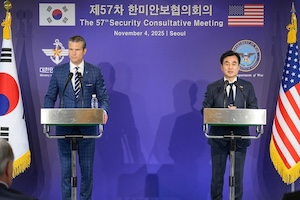South Korea and the U.S. Hold Military Security Talks; Defense Chiefs Visit Panmunjom to Demonstrate Alliance

U.S. Secretary of Defense Pete Hegseth visited South Korea on November 3, joining South Korean Defense Minister Shin Wonn-sik (Ahn Gyu-bae) on an inspection tour of Panmunjom, located within the Demilitarized Zone (DMZ) on the border between North and South Korea. On November 4, the two participated in the annual South Korea–U.S. Military Security Talks, discussing the development of the bilateral military alliance and strategies to counter North Korea’s nuclear threat. Following the meeting, they announced that both nations are drafting a joint communiqué on their military alliance.
Hegseth stated that, to enhance U.S. regional response flexibility, Washington may adjust the role of the 28,500 U.S. troops stationed in South Korea, allowing for more flexible deployment in response to China’s military activities in the South China Sea and around Taiwan, as part of efforts to maintain the balance of military power in Asia. Under pressure from former President Donald Trump, South Korea also pledged to significantly increase its defense spending and strengthen its own military capabilities to counter the threat from North Korea, thereby enabling the U.S. to focus more on countering China’s regional expansion.
On November 4, South Korean President Lee Jae-myung urged lawmakers in the National Assembly to approve an 8.2% increase in next year’s defense budget, aimed at modernizing the military’s weapons systems, enhancing self-defense capabilities, and reducing dependence on the United States.
South Korea currently maintains a military force of about 450,000 personnel, and has continuously upgraded its combat capabilities over the past two decades. Seoul also seeks to take wartime operational control of the ROK-U.S. Combined Forces Command. The South Korean government plans to expand defense spending and take responsibility for maintaining U.S. naval vessels. During his visit to South Korea, Trump also expressed support for South Korea’s plan to build nuclear-powered submarines.
Defense Minister Ahn Gyu-bae stated that if the United States provides nuclear fuel, construction of the first nuclear-powered submarine could be completed around 2035. Regarding the question of whether South Korea would develop nuclear weapons, Ahn emphasized that South Korea is a signatory to the Nuclear Non-Proliferation Treaty (NPT) and therefore, South Korea will not develop nuclear weapons.”
- 37 reads
Human Rights
Fostering a More Humane World: The 28th Eurasian Economic Summi

Conscience, Hope, and Action: Keys to Global Peace and Sustainability

Ringing FOWPAL’s Peace Bell for the World:Nobel Peace Prize Laureates’ Visions and Actions

Protecting the World’s Cultural Diversity for a Sustainable Future

Puppet Show I International Friendship Day 2020

